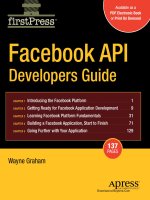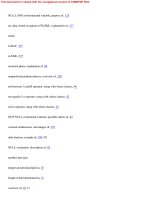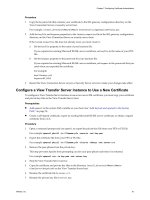Facebook API Developers Guide PHẦN 9 pps
Bạn đang xem bản rút gọn của tài liệu. Xem và tải ngay bản đầy đủ của tài liệu tại đây (451.12 KB, 15 trang )
108 Building a Facebook Application, Start to Finish
Graham
<p><strong>Added:</strong> $added</p>
<p><a href="games.php?action=display&game_id=$game_id">see reviews</a></p>
</div>
<div class="bumper" />
</div>
EOT;
}
print('</div>');
}
You’ll notice here I’m using heredoc notation to save some typing. You could have also
used print or echo, but I find that heredoc is far easier to read, especially when writing a
block of output. You’ll also notice that I added a few new classes to the style sheet.
#games {
padding: 10px;
}
.game {
}
.bumper {
background:#D8DFEA none repeat scroll 0%;
border:medium none;
color:#D8DFEA;
height:1px;
margin-bottom: 21px;
overflow:hidden;
clear: both;
}
.game_header {
font-size: 13px;
}
.game_header a{
font-weight: bold;
}
Now, if you navigate to the games web page, you’ll see something along the lines of
Figure 4-21.
Building a Facebook Application, Start to Finish 109
Graham
Figure 4-21. Listing of games
110 Building a Facebook Application, Start to Finish
Graham
Adding an average rating and the number of reviews for each game is also very easy.
Just write a new function in dbmanager.php to grab the information from the database for
each of the elements:
function get_game_rating($game_id){
$query = query(sprintf('SELECT avg(rating) AS game_rating
FROM review WHERE game_id = %d', $game_id));
if($row = mysql_fetch_assoc($query)){
return round($row['game_rating']);
} else {
return 0;
}
}
function get_game_review_count($game_id){
$query = query(sprintf('SELECT count(*) AS review_count
FROM review WHERE game_id = %d', $game_id));
if($row = mysql_fetch_assoc($query)){
return $row['review_count'];
} else {
return 0;
}
}
Your display should now incorporate this new data, but wouldn’t it be nice if you could
incorporate those little rating stars instead of having a number? The get_game_rating
function returns a rounded average, so you just need to get some stars. I made my own stars,
but if you don’t know how to do this, there are plenty of tutorials online (just Google star
rating tutorial). The basic idea here is that a rating can be from 0 (not rated) to 5 (the
highest rating). You make a file for each of these, and you basically just use the <img>
FBML tag. Remember, the <img> tag in Facebook requires an absolute reference; no relative
URLs are allowed. In other words, you must put the entire path to your image, as in
/>External Web Services
Another nice feature you might want to include is pictures of the covers for the different
games you’re reviewing. Fortunately, you don’t have to store these images yourself; you
can use Amazon’s Amazon Web Service (AWS) to pull the appropriate images into your
application. To use this great service, you’ll need an AWS access key from Amazon. If you
Building a Facebook Application, Start to Finish 111
Graham
don’t already have one, you can sign up at I’ll cover joining the
associate program in the next chapter, but for the time being, you just need an AWS access
key.
Since you’ll probably want to use this on many pages, make a global variable for the
key in the config.inc.php file:
/*********************** Amazon Settings ***************************/
$amazon_key = '<your_amazon_aws_key>';
Now you’ll create a new file named amazon.php in your lib folder to handle your calls to
Amazon’s web service. This is a very basic class object that will work through Amazon’s
REST protocol to query specific XML responses.
<?php
class AmazonClient {
public $amazon_key; // AWS key
public $amazon_associate; // associate id, if you have one
public function __construct($amazon_key, $amazon_associate=''){
$this->amazon_key = $amazon_key;
$this->amazon_associate = $amazon_associate;
}
/**
* Simple REST client for Amazon AWS
* @param $params Query parameters to pass to AWS
* @return SimpleXML object of the REST response
*/
function amazon_search($params){
$url = $this->build_query($params);
$response = file_get_contents($url);
$xmlObject = simplexml_load_string($response);
return $xmlObject;
}
/**
* Function to build query string for AWS
* @param $params search parameters to pass to AWS
* @return AWS REST query URL string
*/
112 Building a Facebook Application, Start to Finish
Graham
function build_query($params){
$constants = array('Service' => 'AWSECommerceService',
'SubscriptionId' => $this->amazon_key,
'AssociateTag' => $this->amazon_id,
'SearchIndex' => 'VideoGames');
$query_string = '';
// add params to search string
foreach($constants as $key => $value){
$query_string .= "$key=" . urlencode($value) . "&";
}
// add searchparams to search string
foreach($params as $key => $value){
$query_string .= "$key=" . urlencode($value) . "&";
}
return = ' . $query_string;
}
/**
* Return an array of the images (small, medium,
* and large) for a given ASIN
* @param $asin The ASIN number to search
*/
function get_game_image($asin){
$params = array( 'Keywords' => $asin,
'Operation' => "ItemSearch",
'ResponseGroup' => 'Images' );
$xml = $this->amazon_search($params);
$results = array();
foreach($xml->Items->Item as $item){
$results['small_url'] = $item->SmallImage->URL;
$results['small_height'] = $item->SmallImage->Height;
$results['small_width'] = $item->SmallImage->Width;
$results['medium_url'] = $item->MediumImage->URL;
$results['medium_height'] = $item->MediumImage->Height;
Building a Facebook Application, Start to Finish 113
Graham
$results['medium_width'] = $item->MediumImage->Width;
$results['large_url'] = $item->LargeImage->URL;
$results['large_height'] = $item->LargeImage->Height;
$results['large_width'] = $item->LargeImage->Width;
}
return $results;
}
}
?>
Tip ➡ Not sure what’s needed in your AWS call? There’s a great online resource at
that lists all the fields you can search for a given search type. If you run into
problems, just fill out the form and see what needs to be in your URL when searching the AWS servers.
Now, all you need to do is include the class, instantiate the object, and call the
get_game_image method. But wait…that method requires a field called ASIN that you
haven’t added to your database. Let’s commit this new tuple to the game table and work on
fixing what you have so far.
First you’ll add the field to the database using the Database Development tool. If you
open the SQL file you created earlier (or a new one) and set your connection information,
you may notice that your database isn’t selected. To see your database, you have to connect
to the database system. You can do this by switching to the Database Development view,
right-clicking your database instance, and selecting Connect (see Figure 4-22).
114 Building a Facebook Application, Start to Finish
Graham
Figure 4-22. Reconnecting to your database back end
Once you have an SQL file open, modify the table definition with this:
ALTER TABLE game ADD COLUMN asin VARCHAR(30) NOT NULL AFTER release_year;
This adds the new ASIN tuple into to the database, but you still need to get the ASINs
(where they exist) for the rest of the games. For convenience, I looked these up already, and
you can just update the game table with the following. We’ll deal with looking up ASINs
when new games are added.
UPDATE game SET asin = 'B0001ZZNNI' WHERE game_id = 1;
UPDATE game SET asin = 'B000B69E9G' WHERE game_id = 2;
UPDATE game SET asin = 'B000GABOTU' WHERE game_id = 3;
UPDATE game SET asin = 'B000B69E9G' WHERE game_id = 4;
UPDATE game SET asin = 'B00002STXN' WHERE game_id = 5;
UPDATE game SET asin = 'B00002SVFV' WHERE game_id = 6;
UPDATE game SET asin = 'B000ID1AKI' WHERE game_id = 7;
UPDATE game SET asin = 'B00000DMB3' WHERE game_id = 8;
UPDATE game SET asin = 'B000FPM8OG' WHERE game_id = 9;
UPDATE game SET asin = 'B000W1XGW6' WHERE game_id = 10;
Building a Facebook Application, Start to Finish 115
Graham
UPDATE game SET asin = 'B000FRU0NU' WHERE game_id = 11;
I like how Amazon displays its images, so let’s put the small image from AWS on the
games page. Now, include the new Amazon page, and call the code:
$require_once('lib/amazon.php');
$amazon = new AmazonClient($amazon_key);
$images = $amazon->get_game_image($row['asin']);
// make sure a structure was returned
if(sizeof($images) > 0){
$image = $images['small_url'];
$img = '<img } else {
$img = 'No Image Available';
}
Now you just need to edit the heredoc string to include a new <div> for the image in the
games.php file:
<div class="game_image">
$img
</div>
Lastly, add a bit of CSS to define the game_image style and then update the game_about
style to clear the image style:
.game_image {
float: left;
}
.game_about {
margin-left: 60px;
}
Let’s take a look at your work now. If everything has gone to plan, you should now
have something that looks like Figure 4-23.
116 Building a Facebook Application, Start to Finish
Graham
Figure 4-23. Games view with images
Game Review
You’re quickly getting a useful application together. Now you’ll build the individual game
review page. You need to write a new query to get all the reviews with a specified game_id.
In the dbmanager.php file, add the following function:
function get_game_reviews($game_id){
$query = query(sprintf('SELECT * FROM review r WHERE game_id = %d
ORDER BY date_submitted DESC', $game_id));
return $query;
}
Building a Facebook Application, Start to Finish 117
Graham
This function simply gets all the information from the review table for the game_id.
Since you have constructed the URL for the action already, you can grab the actual game
information as you did in the previous loop structure by including the following code in the
games.php file:
if(! isset($_REQUEST['game_id'])){
$_REQUEST['game_id'] = 1;
}
$game_id = $_REQUEST['game_id'];
$game = get_game($game_id);
$game_rating = get_game_rating($game_id);
$game_reviews = get_game_reviews($game_id);
$title = $game['game_title'];
$game_id = $game['game_id'];
$publisher = $game['publisher'];
$year = $game['release_year'];
$rating = $game['esrb_rating'];
$added = date('d M, Y', strtotime($game['added']));
$game_rating = get_game_rating($game_id);
$review_count = get_game_review_count($game_id);
$amazon = new AmazonClient($amazon_key);
$images = $amazon->get_game_image($game['asin']);
if(sizeof($images) > 0){
$image = $images['medium_url'];
$img = '<img } else {
$img = 'No Image Available';
}
echo <<<EOT
<div class="game">
<div class="game_image">
$img
</div>
<div class="game_about_medium">
<p class="game_header">
<a href="games.php?game_id=$game_id&action=display">
118 Building a Facebook Application, Start to Finish
Graham
$title
</a>
by $publisher ($year)
</p>
<p>
<strong>Rating:</strong>
<img <your_path_to_images>/$game_rating.png"
alt="$game_rating" title="Average rating of $game_rating" />
($review_count total reviews)
</p>
<p><strong>ESRB Rating:</strong> $rating</p>
<p><strong>Added:</strong> $added</p>
</div>
<div class="bumper" />
</div>
EOT;
This gives you the primary game description (along with a new offset style class that
sets the left margin of the information to 160 pixels since we’re using the medium-sized
image), so let’s take it a step further and add the review information. You’ll style the
reviews basically like a wall, with newer posts at the top:
print('<div id="reviews">');
while($row = mysql_fetch_assoc($game_reviews)){
$uid = $row['uid'];
$rating = $row['rating'];
$review = nl2br($row['review']);
$submitted = strtotime($row['date_submitted']);
$time = date('h:ia', $submitted);
$date = date('d M, Y', $submitted);
$stars = '<your_callback_url>/images/' . $rating . '.png';
echo <<< EOT
<div class="review">
<div class="userimage">
<fb:profile-pic uid="$uid" linked="true" size="q" />
</div>
<div class="review_box">
<div class="review_header">
<fb:name uid="$uid" capitalize="true" linked="true" /> reviewed
Building a Facebook Application, Start to Finish 119
Graham
<strong>$title</strong> <br/>
at $time on $date
</div>
<div class="review_text">
<p>$review</p>
<p><img </div>
</div>
</div>
EOT;
For the reviews, this code used the <fb:name> and <fb:profile-pic> to pull in user data
(including links to the user profiles). You could have made a more sophisticated FQL query
to find the user’s information (name and picture), but using the tags is far more efficient,
especially since these tags were designed specifically to do what you’re doing here.
Add Game
The last thing you need to do for this page is allow people to add new games to your
application, so here you’ll start coding the “add” section. For this action, you’ll use
MockAjax to add information to the form. You could also use the <fb:editor> tag (or just a
plain old HTML form), but the MockAjax facilities for adding a modal dialog box are nice
to work with.
You’ll be nesting your form within the <fb:dialog> tag. The nice part about this is that
you can put this anywhere on your page, and it will be hidden until someone clicks an
action item (for example, a hyperlink) that has a clicktoshowdialog attribute. You’ll then
use the power of FBJS to insert the information into the database and refresh the game
page.
To start, you’ll add a couple of links inside the body <div>. The first one just returns
you to the default view, and the other sets up the call to the dialog box. In the body <div>,
add the following lines:
<a href="games.php">all games</a>
<a href="#" clicktoshowdialog="add_game">add game</a>
Now you’ll add the actual dialog box that get called when the user clicks the Add Game
link:
<fb:dialog id="add_game" cancel_button="1">
<fb:dialog-content>
<form id="add_game_form" method="post" action="add_game.php">
<table>
120 Building a Facebook Application, Start to Finish
Graham
<tr>
<td>Game Title:</td>
<td><input type="text" name="game_title" /></td>
</tr>
<tr>
<td>Publisher:</td>
<td><input type="text" name="publisher" /></td>
</tr>
<tr>
<td>Year Released:</td>
<td><input type="text" name="release_year" /></td>
</tr>
<tr>
<td>Rating:</td>
<td>
<select name="esrb_rating">
<option value="EC">EC</option>
<option value="E" selected>E</option>
<option value="E10+">E10+</option>
<option value="T">T</option>
<option value="M">M</option>
<option value="AO">AO</option>
</select>
</td>
</tr>
</table>
</form>
</fb:dialog-content>
<fb:dialog-button type="submit" value="Add Game" form_id="add_game_form" />
</fb:dialog>
Because you’re using the <fb:dialog> tag, the form will be shown only when the user
clicks the Add Game hyperlink. You pass the entire form a new page (add_game.php) that
contains the logic to add games to the application by referencing the form_id in the
<fb:dialog> tag. The code in add_game.php will handle looking up the ASIN of the game
from Amazon, inserting the data, and redirecting the user to the games.php page with a status
message.
You’ll need to add a couple of functions in the dbmanager.php and AmazonRestClient
code. In the AmazonRestClient, you need a function that will look up an ASIN for a given
title. In the dbmanager.php code, you have a couple of functions, one to tell you whether a
given title has already been inserted in the database and one to insert data into the database.
Building a Facebook Application, Start to Finish 121
Graham
To write the ASIN lookup, you need to retrieve information for a title lookup. This will
be a fairly basic lookup where you assume that the first result passed back from Amazon is
the correct title the person was inserting. In a more sophisticated application, you want to
present the results to the user to let them choose which title they actually wanted.
function asin_lookup($title){
$params = array('Title' => $title, 'Operation' => 'ItemSearch',
'ResponseGroup' => 'ItemAttributes');
$xml = $this->amazon_search($params);
$xml_result = $xml->Items->Item;
return $xml_result->ASIN;
}
Now all that is left is a little checking in the add_game.php page to make sure everything
went OK. First, you want to make sure that the game title doesn’t exist in the database, and
then you look up the ASIN and insert the new game record into the database:
if(isset($_REQUEST['game_title'])){
$game_title = $_REQUEST['game_title'];
$type = "error";
if(game_exists($game_title)){
// check to see if the title exists
$message = "Sorry, looks like " . $game_title .
" is already in our database";
} else {
// check in Amazon
$amazon = new AmazonClient($amazon_key);
$asin = $amazon->asin_lookup($game_title);
if(strlen($asin) > 0){
// double-check this in the database
if(game_exists_asin($asin)){
$message = "Sorry, looks like " . $game_title;
$message += " is already in our database";
} else {
add_game($_REQUEST['game_title'], $_REQUEST['publisher'],
122 Building a Facebook Application, Start to Finish
Graham
$_REQUEST['release_year'], $_REQUEST['esrb_rating'],
$asin);
$message = $_REQUEST['game_title'] . " was successfully added";
$message += " to the database. Please be sure to write a
review!";
$type = "success";
}
} else {
$message = "Sorry, couldn't find " . $_REQUEST['game_title'];
$message += " at Amazon.";
}
}
echo('<fb:redirect url="games.php?message=' . urlencode($message)
. '&type=' . $type . '" />');
}
This code will return a status message in the games.php page that lets the user know
whether a game was added, as well as other information. If a new game was successfully
added, that fact is sent to the user’s profile, and the user is then redirected to the games.php
page. The last thing you want to do at the top of the games.php page is display the message
from the add_game.php code.
Just under the navigation in games.php, add this code to display the messages:
<?php
if(isset($_GET['message'])){
if($_GET['type'] == "success"){
echo('<fb:success message="' . $_GET['message'] . '"/>');
} else {
echo('<fb:error message="' . $_GET['message'] . '"/>');
}
}
?>
This is just a nice way to give the user a little feedback on successful/unsuccessful
actions.
You’ve done the heavy-lifting for your application; now the reviews are a piece of cake.
I won’t go into great detail for this since I’ve covered most of the techniques before. Instead
of filling these pages with code, I’m certain you can write the rest of the code for this
application.









